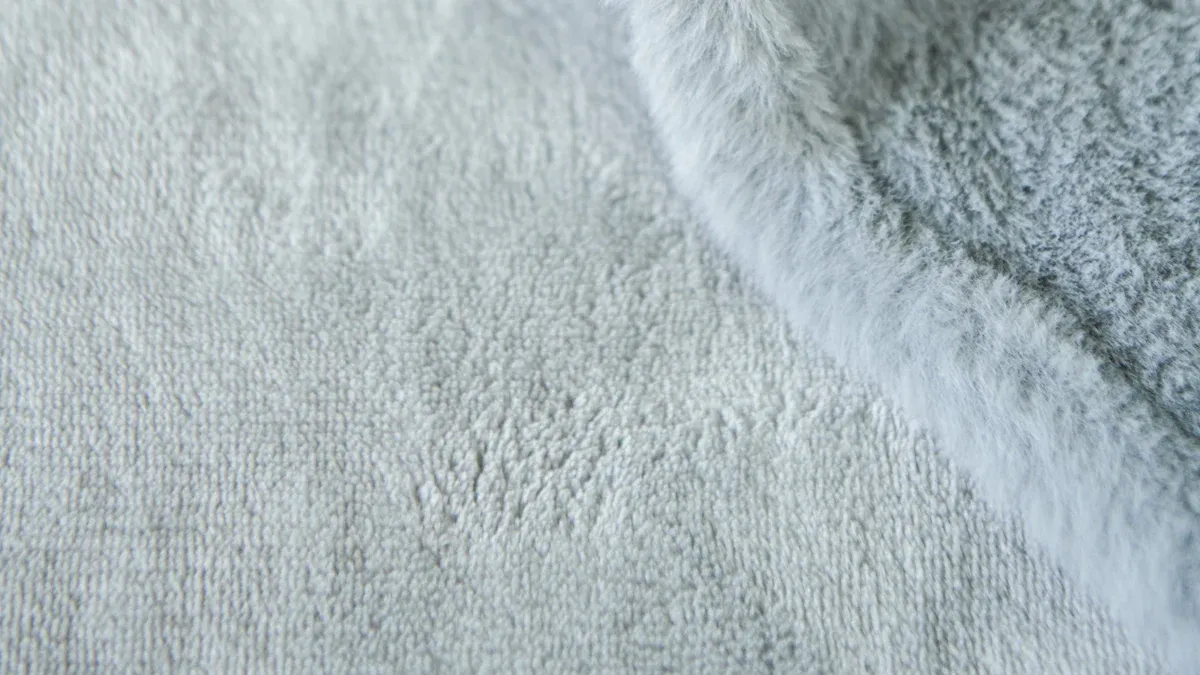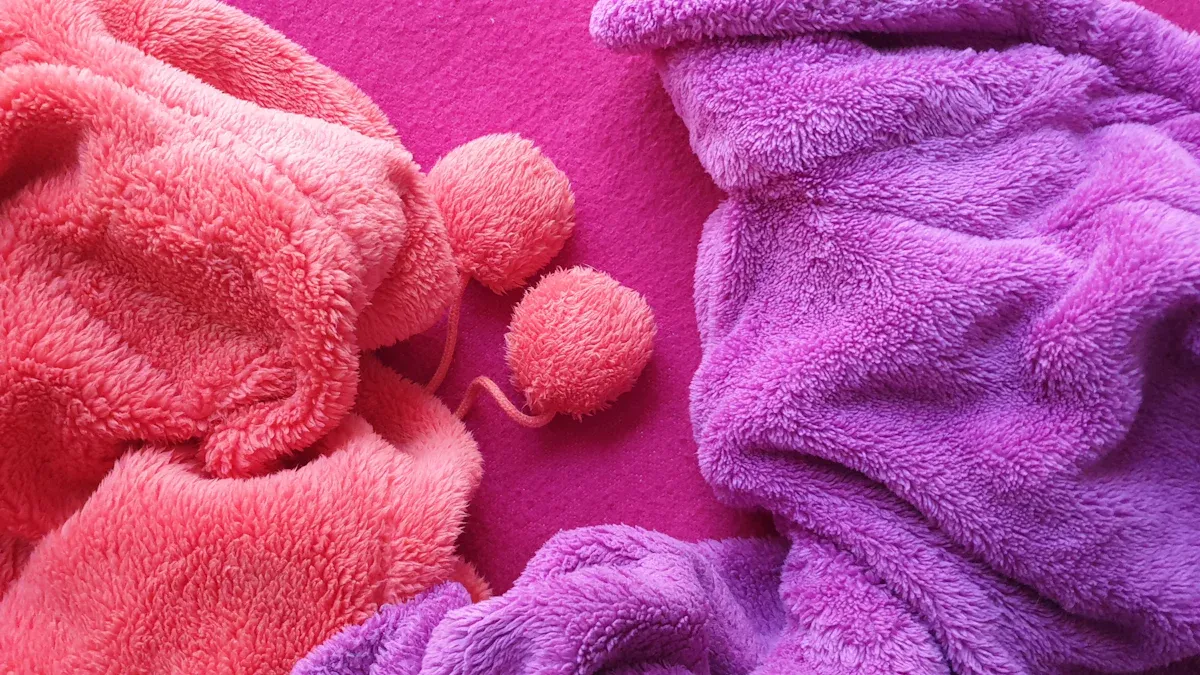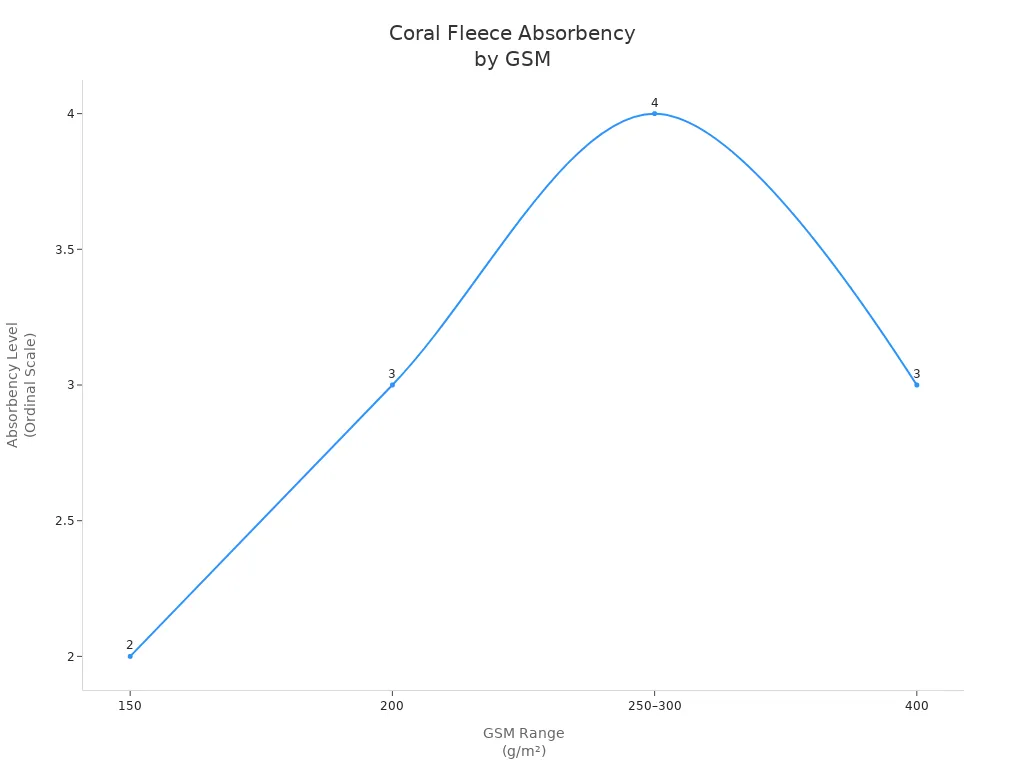
Coral Fleece continues to gain popularity in the textile industry due to its ultra-soft texture and practical benefits. The global market for this fabric is projected to grow from US$ 267 million in 2024 to US$ 366 million by 2030, reflecting steady demand and innovation in product applications.
Key Takeaways
- Coral fleece offers exceptional softness and warmth while remaining lightweight, making it ideal for sensitive skin and cold weather.
- The fabric is easy to care for, durable, and affordable, providing great value for everyday use in clothing and home textiles.
- Users should be aware of static electricity, lint attraction, and limited breathability, but simple care tips can help manage these issues effectively.
What Makes Coral Fleece Unique?

Key Features That Impact Pros and Cons
Coral fleece stands out due to its specialized construction and finishing techniques. Manufacturers use polyester fibers, which they knit into fabric and then brush on both sides. This process raises the fibers, creating a plush, velvety surface with a dense, fluffy texture. The double-sided brushing increases pile density, trapping air and enhancing insulation and softness. Shearing and napping further refine the fabric, resulting in a luxurious feel and excellent warmth retention. The use of imported DTY microfiber polyester fibers adds to its softness and durability. Thin monofilaments with a small bending modulus contribute to the fabric’s gentle touch. High fiber density ensures good coverage and warmth, while the large specific surface area improves air permeability and moisture wicking. However, the same properties that make coral fleece soft and warm also make it prone to static electricity, lint accumulation, and occasional shedding.
Common Uses of Coral Fleece
Coral fleece finds widespread use in both home textiles and apparel. In home settings, people often choose it for blankets, throws, cushion covers, bedspreads, and bathrobes because of its cozy and warm feel. In apparel and accessories, it appears in jackets, hoodies, pajamas, babywear, scarves, gloves, and hats. The fabric’s lightweight and compact nature makes it suitable for travel items and gifts. The table below highlights the differences in its use between home textiles and apparel:
| Aspect | Home Textiles | Apparel and Accessories |
|---|---|---|
| Common Products | Blankets, cushions, throws, bedspreads, upholstery | Jackets, hoodies, pajamas, babywear, scarves, gloves, hats |
| Key Properties Emphasized | Warmth, plush texture, insulation, decor appeal | Warmth, softness, moisture-wicking, insulation, wearability |
| GSM and Thickness Range | Typically lighter versions for blankets and throws | Heavier versions for winter wear and jackets |
| Fabric Types Used | Often double-sided for plushness and insulation | Single-sided for lightweight items; double-sided for warmth |
| Care and Durability | Easy to maintain, durable for frequent use | Durable, moisture-resistant, suitable for sensitive skin |
| Overall Focus | Comfort and warmth combined with home decor | Functionality, insulation, and comfort in wearables |
Top 5 Advantages of Coral Fleece

Softness and Comfort for Sensitive Skin
Coral fleece offers a plush, velvety texture that feels gentle against the skin. Manufacturers use advanced brushing and napping techniques to create a dense pile, resulting in a fabric that provides exceptional softness. This softness makes it an excellent choice for individuals with sensitive skin, including children and those prone to irritation. The fine polyester fibers used in coral fleece contribute to its smooth surface, reducing the risk of chafing or discomfort. Many people prefer this fabric for loungewear, pajamas, and baby products because it delivers a cozy, soothing experience.
Warmth and Lightweight Insulation
Coral fleece delivers impressive warmth without adding bulk. The double-sided brushed construction traps air within the fibers, creating an insulating layer that retains body heat. This design allows the fabric to provide substantial warmth while remaining lightweight and easy to wear. Laboratory studies highlight the thermal efficiency of coral fleece in specialized applications:
- Hansen et al. observed that water coral fleece, when paired with a stepped wire mesh absorber, increased production rates by 71.2% compared to other wick materials in solar stills.
- The same material, combined with a stepped absorber, enhanced production by 48.9%.
- Other tested materials included jute, charcoal cloth, black cotton, and silk cloth, but coral fleece demonstrated superior thermal performance in these settings.
Although explicit thermal conductivity values are not available, these results indicate that coral fleece offers enhanced insulation and productivity compared to many alternative fabrics.
High Water Absorption and Quick Drying
Coral fleece stands out for its moisture management capabilities. The fabric’s deep, fluffy fibers absorb and release moisture efficiently, making it ideal for towels, bathrobes, and cleaning cloths. As the GSM (grams per square meter) increases, both absorbency and softness improve, peaking between 250 and 300 GSM.
| GSM Range (g/m²) | Absorbency Level | Softness Level | Durability Level |
|---|---|---|---|
| 150 | Moderate | Moderate | Moderate |
| 200 | High | Good | High |
| 250–300 | Very High (Peak) | Very High | Very High |
| 400 | High | High | Very High |
Absorbency improves with higher GSM, and coral fleece microfiber can absorb up to seven times its weight in liquid. This performance surpasses that of cotton, which has thicker fibers and slower drying times. Microfiber, including coral fleece, features fibers as fine as 0.1–0.3 dtex, compared to cotton’s 1–2 dtex, enabling faster moisture uptake and release. The following chart illustrates how absorbency peaks at optimal GSM values:

This combination of high absorbency and quick drying makes coral fleece a practical choice for everyday use.
Durability and Resistance to Pilling
Coral fleece demonstrates strong durability and resists common issues like pilling and fading. The synthetic fibers, primarily polyester and nylon, provide a stable structure that withstands frequent washing and wear. This fabric maintains its appearance and texture over time, making it suitable for winter wear, children’s clothing, and home textiles. Compared to other synthetic fabrics, coral fleece offers reliable colorfastness and does not shed lint easily. The table below compares its resistance to fading with similar materials:
| Fabric Type | Composition | Colorfastness & Resistance to Fading | Additional Notes |
|---|---|---|---|
| Coral Fleece | Polyester and Nylon | Reliable, does not fade or lint | Affordable, smooth and soft texture |
| Microfiber | Polyester blend | Colorfast, superior absorbency | Finer fibers, slightly better absorbency |
| Polyester Towels | Polyester | Resistant to fading and shedding | Good colorfastness |
Synthetic fabrics like coral fleece generally outperform natural fibers in maintaining color and resisting wear, ensuring long-lasting use.
Easy Care and Affordability
Coral fleece offers simple maintenance and cost-effective value. Users can machine wash the fabric in cold water with mild detergent to preserve its softness and appearance. The following care tips help extend the life of coral fleece products:
- Use cold water and a gentle machine wash cycle.
- Avoid harsh detergents and high temperatures to prevent fiber damage.
- Air dry or use the lowest dryer temperature to maintain fabric integrity.
- Store items in breathable cotton bags to prevent mustiness.
These straightforward care instructions make coral fleece a practical option for busy households. The fabric’s affordability, combined with its durability and ease of care, appeals to a wide range of consumers seeking comfort and value.
Top 5 Disadvantages of Coral Fleece
Static Electricity Issues
Static electricity presents a common challenge for users of coral fleece. This synthetic fabric accumulates electrical charges because of its polyester composition. When coral fleece rubs against other surfaces, differences in electronegativity between materials cause charge transfer. Friction, environmental dryness, and the hydrophobic nature of synthetic fibers all contribute to static buildup. The lack of conductive properties in coral fleece prevents these charges from dissipating, resulting in noticeable static effects such as crackling sounds or mild shocks.
Note: Dry air increases static electricity in coral fleece. Fibers hold less moisture in low humidity, which makes static buildup more likely. Natural fibers like cotton and wool absorb moisture from the air, reducing static, but coral fleece does not. Using products with conductive filaments or adding fabric softener can help minimize static problems.
Attracts Lint and Pet Hair
Coral fleece tends to attract lint and pet hair, which can be frustrating for pet owners or those seeking a pristine appearance. The plush surface and synthetic fibers create static charges that draw in loose particles from the environment. This property makes the fabric less ideal for households with shedding pets or in dusty settings.
To manage lint and pet hair on coral fleece, consider these effective cleaning methods:
- Use a damp rubber glove to gather pet hair and lint by running your hand over the fabric.
- Run the item through a no-heat dryer cycle for about 10 minutes with dryer sheets to loosen hair and reduce static.
- Shake off any remaining pet hair outside before washing.
- Use a lint roller on smooth surfaces to pick up remaining hair.
- Employ a hand-held steamer to loosen pet hair without damaging the material.
Regular cleaning helps maintain the fabric’s appearance and comfort.
Limited Breathability
Breathability remains a concern for coral fleece, especially when compared to natural fibers. While the woven structure of fleece allows some air to pass through, polyester fibers do not naturally promote airflow. Cotton, for example, features cellulose fibers that evolved to allow oxygen passage, making it much more breathable and suitable for hot weather. Wool also offers good breathability and insulation. Coral fleece performs well in cold conditions due to its insulating properties, but it may feel stuffy or less comfortable in warmer environments. Ultra-lightweight fleece types can approach the breathability of cotton, but most standard coral fleece products do not match the cooling effect of natural fibers.
Synthetic Material Concerns
Coral fleece is made primarily from polyester, a synthetic material derived from non-renewable petroleum resources. This raises several environmental concerns:
- Production of polyester consumes significant energy and contributes to carbon emissions.
- Manufacturing processes release microplastic fibers into water systems during washing, polluting aquatic environments and harming marine life.
- Disposal of synthetic fleece is problematic because it does not biodegrade easily and recycling options remain limited.
- Microplastic pollution from discarded fleece products poses long-term environmental risks.
Some manufacturers now use recycled polyester from post-consumer plastic bottles, which helps reduce the need for new plastic production. Eco-friendly practices, such as recycling programs and reduced water and energy use, also improve the sustainability of fleece fabrics.
Occasional Lint Shedding
Although coral fleece resists pilling and fading, it may shed lint or fibers, especially when new or after repeated washing. This shedding can leave small fibers on other clothing or surfaces. The problem usually decreases after several washes, but it can still be inconvenient for users who prefer low-maintenance fabrics. Washing coral fleece separately and using gentle cycles can help minimize lint shedding.
Coral Fleece Compared to Other Fabrics
Coral Fleece vs. Cotton
Cotton remains a staple in textiles due to its natural softness and breathability. Coral fleece, however, offers a different experience. The synthetic fibers in coral fleece create a plush, velvety surface that feels softer and warmer than cotton. Cotton excels in breathability and works well for all seasons, but it does not provide the same level of insulation as coral fleece. Both fabrics are durable and easy to care for, with machine washing and drying as standard practices. Cotton may appeal to those who prefer natural fibers, while coral fleece suits individuals seeking extra warmth and a luxurious feel.
Tip: For cold climates or winter bedding, coral fleece provides superior warmth compared to cotton.
Coral Fleece vs. Microfiber
Microfiber and coral fleece share similarities as both use synthetic fibers and offer exceptional softness. Microfiber feels lightweight and hypoallergenic, making it ideal for sensitive skin. Coral fleece stands out with its thicker pile and enhanced warmth, mimicking the insulation of wool. Microfiber tends to be more breathable and less insulating, which suits warmer environments. Both fabrics resist wrinkles and dry quickly, making them practical for busy households. When choosing between the two, consider the desired balance between warmth and breathability.
Coral Fleece vs. Wool
Wool is renowned for its natural insulation and moisture-wicking properties. Coral fleece mimics many of wool’s benefits but with easier care requirements. Wool provides superior warmth and excels in cold climates, but it often requires delicate handling, such as hand washing or dry cleaning. Coral fleece, in contrast, withstands regular machine washing and dries quickly. Some wool products may feel coarse, while coral fleece maintains a consistently soft texture. For those who want warmth without the maintenance demands of wool, coral fleece offers a practical alternative.
| Fabric | Softness | Warmth and Insulation | Durability | Care Requirements |
|---|---|---|---|---|
| Coral Fleece | Soft, warm synthetic fabric; distinct texture | Good warmth; mimics wool insulation; lightweight | Durable; withstands regular washing | Easy care; machine washable, quick drying |
| Cotton | Naturally soft and breathable | Less warm; suitable for all seasons | Durable; withstands machine washing | Easy care; machine washable and dryable |
| Microfiber | Incredibly soft, lightweight, hypoallergenic | Lightweight, less insulating | Durable; resistant to wrinkles | Easy maintenance; machine washable, quick drying |
| Wool | Naturally soft but can vary | Superior warmth; excellent insulation | Durable but needs careful handling | Special care; often hand wash or dry clean |
Coral fleece offers softness, warmth, and easy care. Users may notice static, lint, or limited breathability. This fabric works well for cold climates, sensitive skin, or busy households. Readers should review these points and select the best option for their lifestyle and comfort needs.
FAQ
Is coral fleece safe for babies and sensitive skin?
Coral fleece uses fine polyester fibers and a soft finish. Pediatricians often recommend it for baby blankets and clothing due to its gentle, non-irritating texture.
How should users wash coral fleece to prevent damage?
Users should machine wash coral fleece in cold water with mild detergent. Air drying or using a low-heat dryer setting helps maintain softness and prevents fiber damage.
Does coral fleece lose softness after repeated washing?
Coral fleece retains its softness with proper care. Avoiding harsh detergents and high heat ensures the fabric stays plush and comfortable over time.
Post time: Jul-23-2025